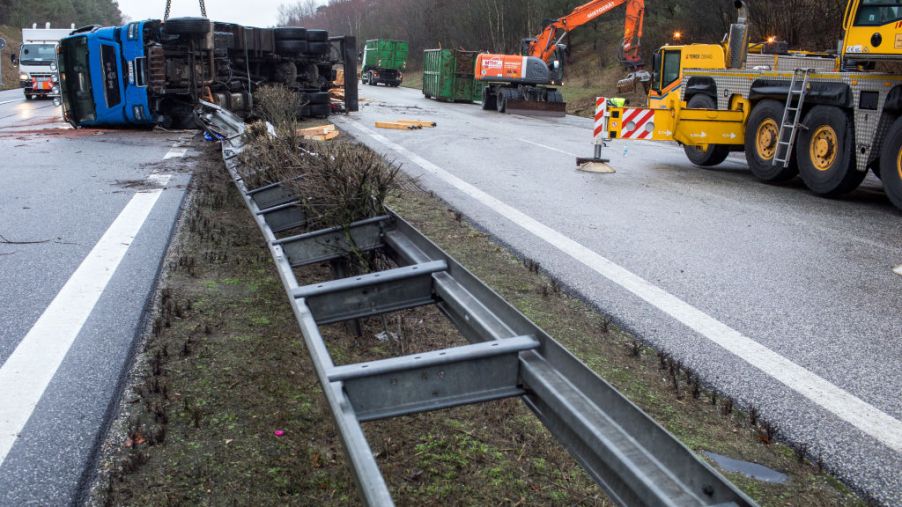
Safety Rules for Logging Trucks Are Shockingly Lax
Even if you haven’t seen Final Destination, driving behind a logging truck tends to be an anxiety-ridden task. A recent accident in Georgia, where an Xterra was speared through the windshield, hasn’t exactly helped. In this case, the accident was the Nissan driver’s fault: he was bent down, looking on the floor for something. And he came away with minor injuries. However, accidents like this do highlight something: when it comes to logging and other commercial truck safety, there are some gaps to fill.
Commercial Truck Driver Fatigue and Behavior
At the moment, the Department of Transportation has a number of regulations in place to prevent driver fatigue. Truckers cannot drive more than 11 hours in a given 14-hour period unless they encounter adverse conditions. Truckers also must be off-duty for 10 hours before they can get back on the road, and have a weekly limit on driving hours. Part of this enforcement came with the help of the Federal Motor Carrier Safety Administration. In 2017, the FMCSA began requiring truck carriers to install electronic log devices in all their vehicles. These ELDs replaced the physical logbook previously required; it was too easy to falsify records.
However, there have been proposals by the FMCSA to relax some of those time limitations. But even if these changes don’t pass, that won’t solve the underlying issue. Truckers want and need to get to where they’re going on time to do their jobs and make money. That means, for instance, sometimes speeding. And as lumber industry consultants Forisk Consulting explain, that can invalidate drivers from insurance coverage. And even if coverage is obtained, infractions mean higher premiums. Which means logging companies generate less revenue, putting additional pressure on the drivers. And so, the cycle continues.
Situations like these also mean companies can’t invest in, among other things, safer trucks.
Mandatory Crash Avoidance Features

Laws mandate the presence of certain safety features in every new car and truck. Some of these, such as electronic stability control, are also mandated on commercial trucks. ESC in particular has been required since August 2017.
However, new trucks aren’t the only vehicles on the road. Older vehicles may not come with the full arsenal of anti-collision features. And even new trucks’ safety systems may not cover the full spectrum of available tech. In a 2018 report, Consumer Reports stated that only 15% of all commercial trucks on the road as of 2015 had forward-collision warning or automatic emergency braking. Although not required on new vehicles, FCW and AEB are just a few of the safety features that result in five-star ratings from the NHTSA and IIHS.

It’s not that manufacturers don’t offer options such as this. Peterbilt, for instance, offers lane departure warning, collision mitigation, and object ID as part of a suite of safety systems on its Model 579. But that particular truck is a fairly high-end vehicle. Less luxurious trucks’ literature notably lacks safety feature information. There isn’t even a blurb about the ESC, and it’s mandatory. Other manufacturers—apart from famous safety advocate Volvo—have similar gaps in their product literature.
But even the best safety software and sensors can’t overcome physics.
Car-Logging Truck Interaction
Driving a commercial logging truck is difficult. Commercial trucks are significantly more complicated than most of us realize, or care to appreciate. Truckers have to keep track of a larger flow of information, all while operating a very large vehicle at speed. That’s why driver’s education courses stress that car drivers avoid a truck’s blind spots. To always make sure the trucker knows where you are.
And yet. People speed. They don’t signal. They cut in front of the big semi. And they’re distracted, usually with their phones. Or because something fell on the floor.
Regardless of how, if a semi-truck and a normal passenger vehicle collide, it isn’t the semi that gets the worst of it. The IIHS discussed in their recent collision study that weight disparity is one of the biggest factors behind driver death in pickup truck-car collisions. A semi-truck hitting a Camry, for instance, is going to be significantly worse for the Camry than if an F-150 hit it.
There have been some attempts to prevent such incidents, such as with a proposed “underride guard” to stop cars sliding underneath trailers. But in this case, one of the best ways to avoid accidents like that Xterra is to always pay attention.


